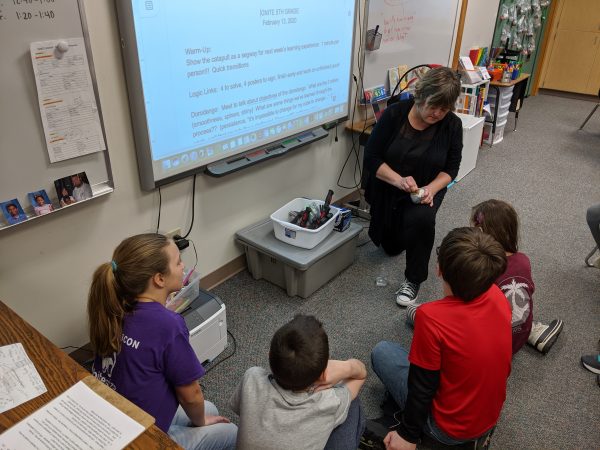
Listen to this story:
The Anchorage School District has a program specifically for academically-gifted elementary students called Including Gifted Needs in Today’s Education or IGNITE. It’s been in existence for nearly 45 years and currently serves more than 2,000 students.
When the Anchorage School District revealed a projected $20 million budget shortfall for next school year and proposed redesigning the gifted program to save money, community members voiced concern.
Read more: Anchorage School District proposes scaling back gifted program to address budget shortfall
Margaret McIntyre, an IGNITE teacher at Ocean View Elementary, said her students wouldn’t have the time they need to focus on developing social and emotional skills under the district’s proposed changes.
“It’s frustrating for me because I see that the kids that are falling at the other ends of the bell curve, kids that are struggling or the kids that are highly gifted, are sitting in the classroom and, for lack of a better word, atrophying,” she said.
Students qualify to be part of the IGNITE program through a series of tests, teacher recommendations and other criteria. Once a week, students are pulled out of their home classroom for a two or three hour session of enrichment activities.
McIntyre has been leading IGNITE sessions for two years, and has over 20 years of teaching experience. She said IGNITE activities like creating aluminum foil dorodangos (a Japanese-style decoration made by molding a material into a perfect, shiny sphere by hand) or dissecting cow eyeballs are designed to teach students skills like patience and attention to detail.
“Sometimes it’s more difficult (for gifted students) to work with their peers, because (they believe) they know the answer,” she said. “And that’s the answer. And I don’t know why we’re even talking about it anymore, if that’s the answer.”

But the entire structure of IGNITE could soon change.
Under the district’s current budget proposal, students will no longer be pulled out of class to receive direct instruction from IGNITE teachers. The program’s staff will shrink from 22 teachers to 11, at most. Then, current staff will be able to apply for one of those remaining positions and become coaches for homeroom teachers.
As coaches, they will help homeroom teachers incorporate enrichment activities into students’ “What I Need” or “WIN” time. WIN time is a daily 40-minute block that is already built into all students’ schedules to help them focus on individual learning goals.
Deputy Superintendent Mark Stock said the criticism that the gifted programming is going away is a misconception.
“IGNITE is not being cut,” he said “IGNITE is being redesigned, and it will look different, it will feel different, and it’s going to feel a little bit of a mystery until we can get through a year and get through the schedules and get through how it’s designed.”
Stock said that after a community-wide survey and extensive input from various departments and educators, the IGNITE changes met all of the district’s criteria of preserving classroom sizes, keeping some educational programming and saving jobs.
“Quite frankly, at this point, no one’s really been able to come up with another idea that meets all three of those” he said.
Changing IGNITE will save the district about $2 million — a tenth of its current budget gap.
Other changes in the proposal include absorbing elementary health instruction into P.E. or other classroom time and a one-hour late start or early dismissal day per week for all schools.
School Board Member Andy Holleman, whose son was an IGNITE student, said he didn’t expect there to be so much passion for the program.
The issue is mainly a convergence of bad timing, years of flat education funding from the state and uncertainty over the governor’s budget, he said.
“We have to have a revenue number on the one side of that budget that is based in some kind of reality,” he said. “And right now, it’s based on the proposed budget that the governor has given the legislature. We don’t actually know what it’s going to be.”
Last year, Gov. Mike Dunleavy proposed closing the state’s budget gap, in part, by cutting funding for public schools by more than 25 percent. He has since backed off that idea. His latest budget proposal keeps education funding flat.
Read more: With a recall looming, the session opens quietly, the governor no longer a firebrand on budget cuts
Holleman said he’s trying to think creatively about possible alternative funding sources for Anchorage schools.
“One of the things we will ask the administration is to delay this as long as possible, in case we can find funding,” he said. “And there is discussion from people in the community about looking for outside funds.”
As for McIntyre, she said if the changes go through, then she’ll apply for one of the new coaching positions. She sees herself as an advocate for IGNITE students, but she’s not optimistic about the program’s future.
“I do not think that it’s a good replacement. It’s not a redesign,” she said. “They’re cutting a program and adding a greater workload to the WIN group. It’s not appropriate for gifted learners.”
The school board will vote on whether to approve the budget changes Tuesday night.




